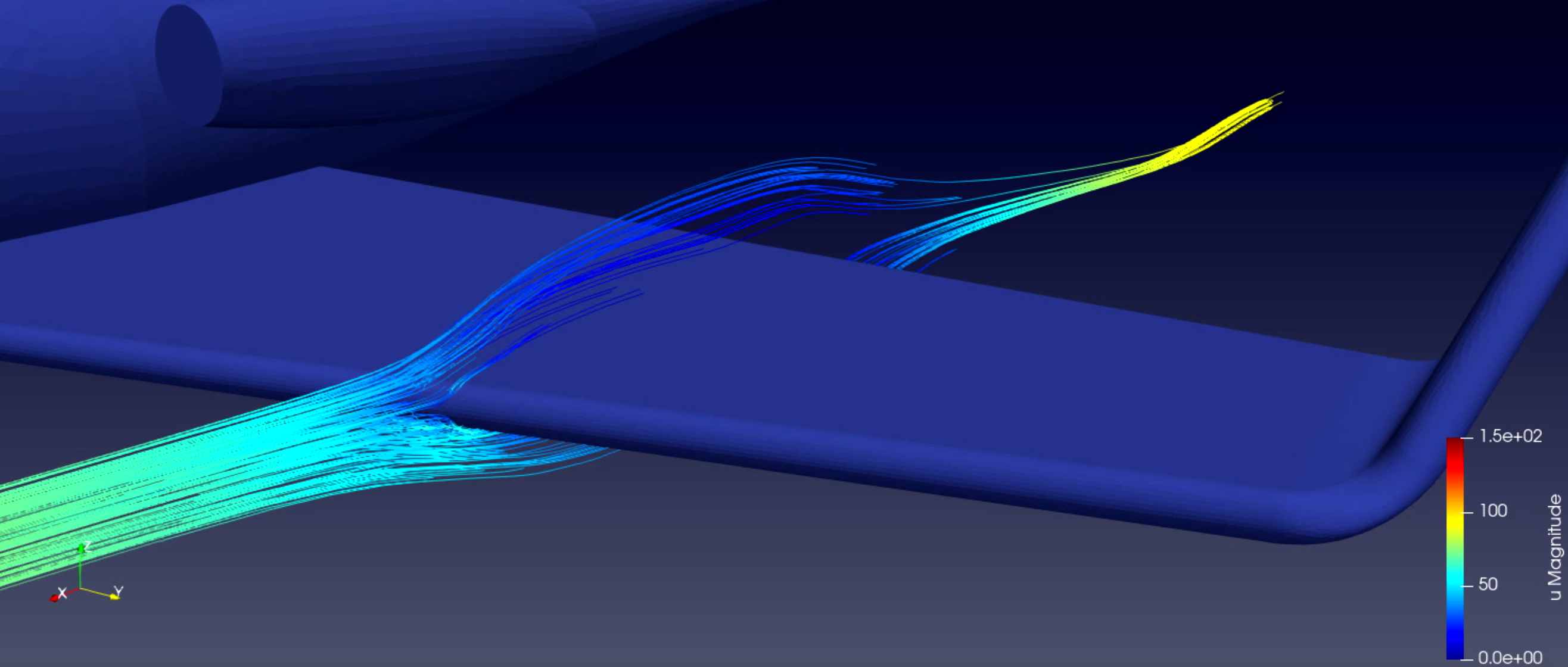6. NGSolve Model Templates:#
A python library on top of NGSolve providing state of the art numerical methods for many equations.
pip3 install --user git+https://github.com/NGSolve/modeltemplates
6.1. Navier Stokes#
hybrid mixed method for Navier-Stokes (Gopalakrishnan+Lederer+Schöberl ‘20,’20), Dissertation Lederer 2019
from ngsolve import *
from netgen.occ import *
from ngsolve.webgui import Draw
import ipywidgets as widgets
shape = Rectangle(2,0.41).Circle(0.2,0.2,0.05).Reverse().Face()
shape.edges.name="wall"
shape.edges.Min(X).name="inlet"
shape.edges.Max(X).name="outlet"
Draw (shape)
mesh = Mesh(OCCGeometry(shape, dim=2).GenerateMesh(maxh=0.07)).Curve(3)
Draw (mesh);
from ngs_templates.NavierStokes import *
ngsglobals.msg_level = 0
timestep = 0.001
navstokes = NavierStokes (mesh, nu=0.001, order=4, timestep = timestep,
inflow="inlet", outflow="outlet", wall="wall|cyl",
uin=CoefficientFunction( (1.5*4*y*(0.41-y)/(0.41*0.41), 0) ))
navstokes.SolveInitial()
scene = Draw (Norm(navstokes.velocity), mesh, "velocity")
tw = widgets.Text(value='t = 0')
display(tw)
tend = 5
t = 0
cnt = 0
with TaskManager():
while t < tend:
navstokes.DoTimeStep()
t = t+timestep
cnt = cnt+1
if cnt % 100 == 0:
tw.value = "t = "+str(t)
scene.Redraw()
6.2. The code for the MCS - Navier-Stokes solver#
MCS mixed method from [Lederer+Gopalakrishnan+JS,20]
velocity \(u_h \in BDM^k \subset H(\operatorname{div})\) and stress \(\sigma_h \in H(\operatorname{div} \operatorname{curl})\)
upwind DG for convetive term
uses SIMPLE time-stepping
hybrid mixed system for pressure correction
class NavierStokes:
def __init__(self, mesh, nu, inflow, outflow, wall, uin, timestep, order=2, volumeforce=None):
self.nu = nu
self.timestep = timestep
self.uin = uin
self.inflow = inflow
self.outflow = outflow
self.wall = wall
V = HDiv(mesh, order=order, dirichlet=inflow+"|"+wall, RT=False)
self.V = V
Vhat = TangentialFacetFESpace(mesh, order=order-1, dirichlet=inflow+"|"+wall+"|"+outflow)
Sigma = HCurlDiv(mesh, order = order-1, orderinner=order, discontinuous=True)
if mesh.dim == 2:
S = L2(mesh, order=order-1)
else:
S = VectorL2(mesh, order=order-1)
Sigma.SetCouplingType(IntRange(0,Sigma.ndof), COUPLING_TYPE.HIDDEN_DOF)
Sigma = Compress(Sigma)
S.SetCouplingType(IntRange(0,S.ndof), COUPLING_TYPE.HIDDEN_DOF)
S = Compress(S)
self.X = V*Vhat*Sigma*S
for i in range(self.X.ndof):
if self.X.CouplingType(i) == COUPLING_TYPE.WIREBASKET_DOF:
self.X.SetCouplingType(i, COUPLING_TYPE.INTERFACE_DOF)
# self.v1dofs = self.X.Range(0)
u, uhat, sigma, W = self.X.TrialFunction()
v, vhat, tau, R = self.X.TestFunction()
if mesh.dim == 2:
def Skew2Vec(m):
return m[1,0]-m[0,1]
else:
def Skew2Vec(m):
return CoefficientFunction( (m[0,1]-m[1,0], m[2,0]-m[0,2], m[1,2]-m[2,1]) )
dS = dx(element_boundary=True)
n = specialcf.normal(mesh.dim)
def tang(u): return u-(u*n)*n
stokesA = -0.5/nu * InnerProduct(sigma,tau) * dx + \
(div(sigma)*v+div(tau)*u) * dx + \
(InnerProduct(W,Skew2Vec(tau)) + InnerProduct(R,Skew2Vec(sigma))) * dx + \
-(((sigma*n)*n) * (v*n) + ((tau*n)*n )* (u*n)) * dS + \
(-(sigma*n)*tang(vhat) - (tau*n)*tang(uhat)) * dS
self.astokes = BilinearForm (self.X, eliminate_hidden = True)
self.astokes += stokesA
self.astokes += 1e12*nu*div(u)*div(v) * dx
self.a = BilinearForm (self.X, eliminate_hidden = True)
self.a += stokesA
self.gfu = GridFunction(self.X)
self.f = LinearForm(self.X)
self.mstar = BilinearForm(self.X, eliminate_hidden = True, condense=True)
self.mstar += u*v * dx + timestep * stokesA
self.premstar = Preconditioner(self.mstar, "bddc")
self.mstar.Assemble()
# self.invmstar = self.mstar.mat.Inverse(self.X.FreeDofs(), inverse="sparsecholesky")
# self.invmstar1 = self.mstar.mat.Inverse(self.X.FreeDofs(self.mstar.condense), inverse="sparsecholesky")
self.invmstar1 = CGSolver(self.mstar.mat, pre=self.premstar, precision=1e-4, printrates=False)
ext = IdentityMatrix()+self.mstar.harmonic_extension
extT = IdentityMatrix()+self.mstar.harmonic_extension_trans
self.invmstar = ext @ self.invmstar1 @ extT + self.mstar.inner_solve
# the convective term
if True:
u,v = V.TnT()
self.conv = BilinearForm(V, nonassemble=True)
self.conv += InnerProduct(grad(v)*u, u).Compile(realcompile=realcompile, wait=True) * dx
self.conv += (-IfPos(u * n, u*n*u*v, u*n*u.Other(bnd=self.uin)*v)).Compile(realcompile=realcompile, wait=True) * dS
rest = self.X.Restriction(0)
self.conv_operator = rest.T @ self.conv.mat @ rest
else:
VL2 = VectorL2(mesh, order=order, piola=True)
ul2,vl2 = VL2.TnT()
self.conv_l2 = BilinearForm(VL2, nonassemble=True)
self.conv_l2 += InnerProduct(grad(vl2)*ul2, ul2).Compile(realcompile=realcompile, wait=True) * dx
self.conv_l2 += (-IfPos(ul2 * n, ul2*n*ul2*vl2, ul2*n*ul2.Other(bnd=self.uin)*vl2)).Compile(realcompile=realcompile, wait=True) * dS
self.convertl2 = V.ConvertL2Operator(VL2) @ self.X.Restriction(0)
self.conv_operator = self.convertl2.T @ self.conv_l2.mat @ self.convertl2
# setup problem for pressure projection (hybrid mixed)
# self.V2 = Discontinuous(self.V)
self.V2 = HDiv(mesh, order=order, dirichlet=inflow+"|"+wall, RT=False, discontinuous=True)
self.Q = L2(mesh, order=order-1)
self.Qhat = FacetFESpace(mesh, order=order, dirichlet=outflow)
self.Xproj = self.V2*self.Q*self.Qhat
(u,p,phat),(v,q,qhat) = self.Xproj.TnT()
aproj = BilinearForm(self.Xproj, condense=True)
aproj += (-u*v+ div(u)*q + div(v)*p) * dx + (u*n*qhat+v*n*phat) * dS
# cproj = Preconditioner(aproj, "bddc", coarsetype="h1amg")
# cproj = Preconditioner(aproj, "bddc")
# cproj = Preconditioner(aproj, "gamg")
cproj = Preconditioner(aproj, "bddc", coarsetype="gamg")
aproj.Assemble()
# self.invproj1 = aproj.mat.Inverse(self.Xproj.FreeDofs(aproj.condense), inverse="sparsecholesky")
self.invproj1 = CGSolver(aproj.mat, pre=cproj, printrates=False)
ext = IdentityMatrix()+aproj.harmonic_extension
# extT = IdentityMatrix()+aproj.harmonic_extension_trans
self.invproj = ext @ self.invproj1 @ ext.T + aproj.inner_solve
self.bproj = BilinearForm(div(self.V.TrialFunction())*q*dx).Assemble()
# mapping of discontinuous to continuous H(div)
ind = self.V.ndof * [0]
for el in mesh.Elements(VOL):
dofs1 = self.V.GetDofNrs(el)
dofs2 = self.V2.GetDofNrs(el)
for d1,d2 in zip(dofs1,dofs2):
ind[d1] = d2
self.mapV = PermutationMatrix(self.Xproj.ndof, ind)
@property
def velocity(self):
return self.gfu.components[0]
@property
def pressure(self):
return 1e6/self.nu*div(self.gfu.components[0])
def SolveInitial(self):
self.a.Assemble()
self.f.Assemble()
temp = self.a.mat.CreateColVector()
self.gfu.components[0].Set (self.uin, definedon=self.X.mesh.Boundaries(self.inflow))
self.gfu.components[1].Set (self.uin, definedon=self.X.mesh.Boundaries(self.inflow))
self.astokes.Assemble()
inv = self.astokes.mat.Inverse(self.X.FreeDofs(), inverse="sparsecholesky")
temp.data = -self.astokes.mat * self.gfu.vec + self.f.vec
self.gfu.vec.data += inv * temp
def AddForce(self, force):
force = CoefficientFunction(force)
v, vhat, tau, R = self.X.TestFunction()
self.f += force*v*dx
def DoTimeStep(self):
self.temp = self.a.mat.CreateColVector()
self.temp2 = self.a.mat.CreateRowVector()
self.f.Assemble()
self.temp.data = self.conv_operator * self.gfu.vec
self.temp.data += self.f.vec
self.temp.data += -self.a.mat * self.gfu.vec
self.temp2.data = self.invmstar * self.temp
# self.ProjectFull(self.temp2)
self.Project(self.temp2[self.X.Range(0)])
self.gfu.vec.data += self.timestep * self.temp2.data
def Project(self,vel):
vel.data -= self.mapV @ self.invproj @ self.bproj.mat * vel
def ProjectFull(self,vel):
emb = self.X.Embedding(0)
rest = self.X.Restriction(0)
# opinfo = (emb@self.mapV @ self.invproj @ self.bproj.mat@rest).GetOperatorInfo()
# print ("project operator =", opinfo)
vel.data -= emb @ self.mapV @ self.invproj @ self.bproj.mat @ rest * vel
Our first flying plane (by Philip Lederer)

